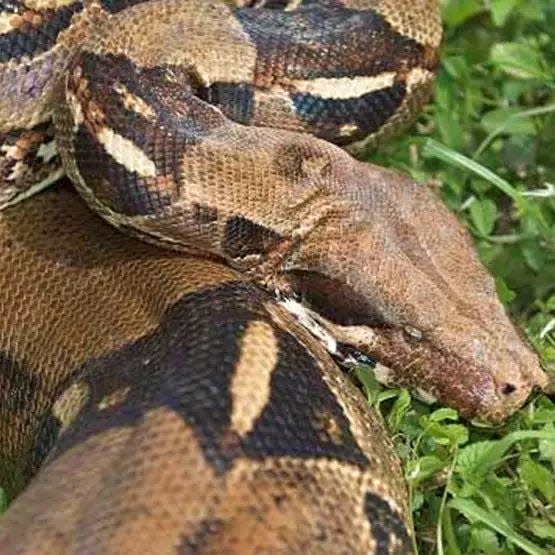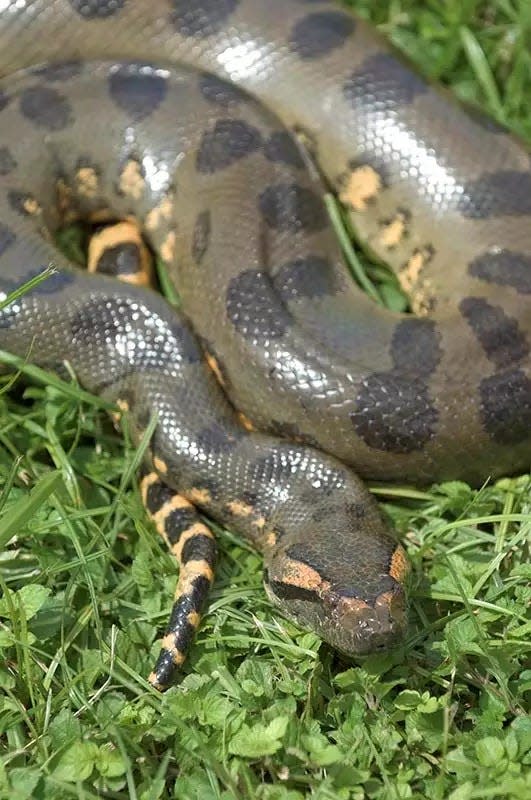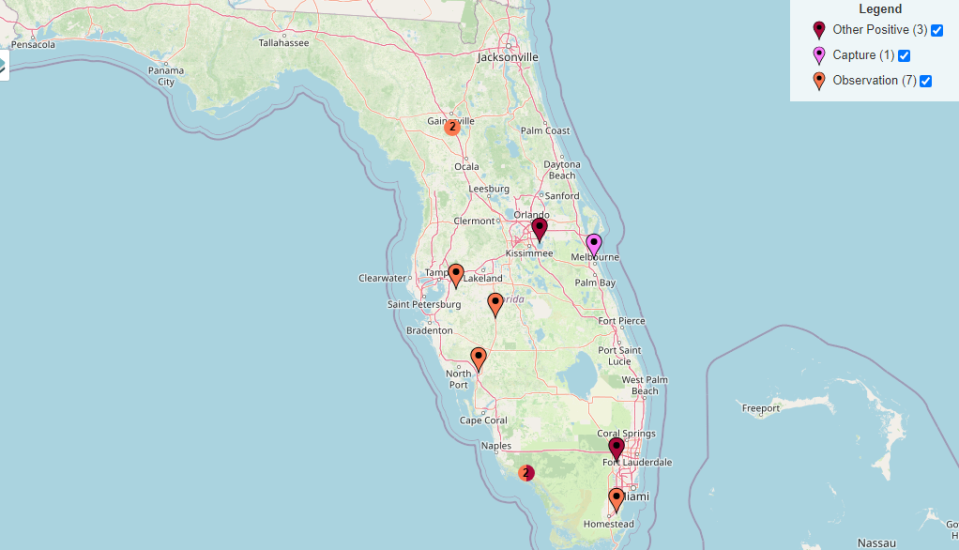Burmese pythons aren't only constrictors seen in Florida. Say hi to green anacondas, boas
Forget those lions, tigers and bears.
Think more pythons, boas and anacondas. In Florida.
Oh my.
While attention usually focuses on the Burmese python population wreaking havoc across the Florida Everglades and slithering its way north, green anacondas and boa constrictors also have been seen making their home in the Sunshine State.
Did you know?: Get to know Burmese Pythons: Q&A to help you better understand invasive Florida snake
Here's where they've been seen, how to tell them apart and what you should know.
Burmese python one of world's largest snakes
Burmese pythons are not native to Florida and are considered an invasive species due to their impacts to native wildlife, according to the Florida Fish and Wildlife Commission.
They are not protected in Florida except by anti-cruelty law and can be humanely killed on private property with the landowner's permission. They also can be captured and humanely killed all year without a permit or hunting license on 32 commission-managed lands in South Florida.
Burmese pythons were added to Florida’s prohibited species list in April 2021 and are listed by the U.S. Fish and Wildlife Service as an injurious species, preventing them from being imported into the United States.
Length: The Burmese python is one of the largest snakes in the world. Adult Burmese pythons caught in Florida average between 6 to 9 feet. The largest Burmese captured in Florida measured over 18 feet.
Coloring: Burmese pythons are tan in color with dark blotches along the back and sides. The blotches look like puzzle pieces or the markings on a giraffe. They have a pyramid-shaped head with a dark, arrowhead-shaped wedge extending toward the nose.
Prey: In Florida, Burmese pythons have been found to prey upon a variety of mammals — including livestock — birds and reptiles. They can take prey as large as white-tailed deer and alligators. They may also prey upon such pets as cats and dogs. Burmese pythons can pose a threat to people because of their large size, the FWC said.

Florida populations: A population of Burmese pythons is established in South Florida. Historically, the python population was centered within Everglades National Park in Miami-Dade County. Burmese pythons are currently considered established from just south of Lake Okeechobee to Key Largo and from western Broward County west to Collier County, according to the FWC.
Some pythons have been found in Southwest Florida in Naples and near Lake Okeechobee. Python observations outside of South and Southwest Florida are likely escaped or released animals, the FWC said.
Predators: Because of their large size, adult Burmese pythons have few predators, with humans being the exception.
Burmese python fast facts:
First introduced to the wild in Florida via the pet trade as early as 1979.
Now established in South Florida, particularly Miami-Dade, Collier, and Monroe counties.
More than 12,000 Burmese pythons have been removed from Florida by the FWC and others as of October 2020.
Females are capable of laying 50-100 eggs annually.
They are well camouflaged and difficult to detect in the wild.
One population of boa constrictors found in Florida

Boa constrictors, especially red-tailed boas, are common in the pet trade, according to the FWC.
Length: These medium-sized constrictors can grow to about 11 feet in length and can show considerable color and pattern variation.
Florida population: There is one reproducing population of boa constrictors in Florida, in eastern Miami-Dade County.
Coloring: Typical boa constrictors are tan in color with darker brown markings down the back and sides.
Distinguishing characteristics:
Faint, narrow line down the center of the head.
Tan ovals down the back, separated by darker saddles.
Saddles have a light spot on each side.
Sightings of green anacondas range from Gainesville to Miami

Green anacondas also are considered an invasive species due to their impacts to native wildlife, the FWC said. They are not protected in Florida except by anti-cruelty law and can be humanely killed on private property with landowner permission. This species can be captured and humanely killed year-round and without a permit or hunting license on commission-managed lands in South Florida.
In April 2021, green anacondas were added to Florida’s prohibited species list, and the U.S. Fish and Wildlife Service lists green anacondas as an injurious species under the Lacey Act.
Length: Green anacondas can grow over 21 feet long and their mid-body diameter can be over a foot. They are considered the world's heaviest snake, with larger animals reaching more than 400 pounds, the FWC said.
Coloring: They are an olive green color, with dark dorsal splotches and lighter color blotches along their sides. They have a blunt head shape with two black stripes on either side, emanating from each eye.

Florida populations: Green anacondas have had relatively few sightings in Florida, with the majority found around Central and north Central Florida. They have been reported as far north as Gainesville and as far south as Miami near Everglades City. Seven green anacondas have been removed from Florida by the FWC and others as of October 2020. "Being semi-aquatic, they can easily traverse dry land or lakes and rivers, which makes Florida a good habitat for them."
Prey: "Given their size and the variety of animals anacondas may consume, this species would have few predators in Florida and poses a potential threat to a number of native species," the FWC said. Because of their size, they "may pose a threat to human safety if approached or threatened."
In Florida, green anacondas could prey on a variety of native wildlife, including white-tailed deer, alligators, crocodiles, wading birds, and other birds, mammals and reptiles.
Anaconda fast facts:
Anacondas were first introduced to the wild in Florida via the pet trade as early as 2004.
Females give birth to an average of 28 to 42 live offspring every other year.
Considered apex predators, FWC said green anacondas could cause similar, if not more severe, adverse impacts to native wildlife than Burmese pythons.
The FWC said it rapidly responds to reports of green anacondas to remove them from the wild and prevent their establishment.
How can you tell the difference between a boa constrictor and a Burmese python?
The FWC offered the following characteristics to tell the difference between the two:
Boa constrictors have tan ovals separated by darker saddles and a thin line down the back of the head.
Burmese pythons have angular tan blotches that resemble a giraffe pattern and a dark wedge on the back of the head.
Can you kill non-native species like the python or anaconda?
Nonnative reptiles are not protected in Florida except by anti-cruelty law. There is an ethical and legal obligation to ensure nonnative reptiles are killed in a humane manner, the FWC said
The American Veterinary Medical Association recommends a two-step process to prevent suffering and destroy the brain completely for the humane killing of reptiles.
Many methods are available to kill non-native reptiles. Regardless of the method you use, you must ensure the following two steps are completed to humanely kill a reptile:
Step 1: Your method should result in the animal losing consciousness immediately.
Step 2: You should then destroy the animal's brain by “pithing,” which prevents the animal from regaining consciousness.
This article originally appeared on Treasure Coast Newspapers: Florida snakes: Burmese pythons, green anacondas, boa constrictors

